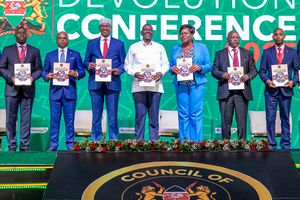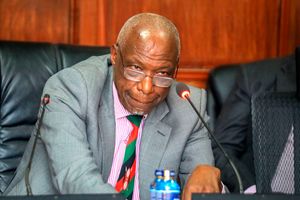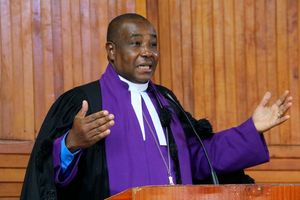Premium
Martha Koome’s optics risk eroding public confidence in the Judiciary

Chief Justice Martha Koome during an interview at her office in Nairobi on September 9, 2021.
What you need to know:
- Justice Koome's enthusiasm in pursuit of the agenda to render the Judiciary vulnerable to Executive annexation is stunning.
- The Chief Justice has also displayed particularly rapturous delight in the company of the autocratic potentates of the Interior Ministry.
Chief Justice Martha Koome can be exasperatingly indeterminate. The salient intellectual and ideological components of her philosophy are fairly at large, notwithstanding long decades in the field. Similarly, her definitive commitments are, despite her high profile, shockingly unaccounted-for. Her ambivalence at signal junctures form a discernible pattern.
Whenever circumstances demand that she take a strong stand for the judicial staples of human rights, the rule of law, judicial independence and constitutionalism, she instead collapses into silence and ambiguity, if not downright appeasement of the Executive.
However, she displays none of that reticence when the chance to subordinate the Judiciary to the Executive arm arises.
Then, Hon. Koome demonstrates dispatch of the swiftest order, and a capacity to take orders that would do any soldier proud.
Her enthusiasm in pursuit of the agenda to render the Judiciary vulnerable to Executive annexation is stunning, as is her appetite for institutional transgressions.
It may be said that in important ways, we did not see Hon. Koome coming, both in the sense of her wild card rise to the head of the Judicial arm of government, and her zeal to enable the diminution of the judicial authority of the republic, mainly by the Executive. We did not see her because she was hiding in plain sight.
Her appointment following an accelerated process was especially notable because in contrast, 34 of 41 judges had to wait for two years to be sworn in, while the remainder remain disappointed to date.
Hon. Koome’s attitude to her colleagues’ travails has been unsettling.
Equating government with the family unit, she proceeded to privilege the Executive whilst infantilising the other arms in an abhorrent metaphor that graphically delineated potentially violent power dynamics.
Public contempt
She swiftly proceeded to demonstrate her deference as head of the Judiciary by bowing before the head of the Executive, a coequal arm of government.
This gesture may have been, and indeed should generously have been deemed harmless in gentler times.
However, Hon. Koome was bowing and scraping at a time of acute executive distemper signified by large-scale violation of fundamental rights and freedoms, public contempt for the judiciary, wanton disobedience of innumerable court orders as well as a campaign of revisiting waged through the infliction of personal and professional distress on hapless judges.
Following public pressure to do something about the disdained judicial appointees, Hon. Koome made diffident noises about the need to obey court orders, qualified by a more resolute vow to lobby the President informally. No evidence of progress in this matter is forthcoming, and there is no reason whatsoever to imagine that the Chief Justice is immersed in frantic back-channel exertions on behalf of her dreadfully profiled and betrayed colleagues.
For good measure, Hon. Koome began to make appearances at spectacularly awkward encounters.
Under the pretext of forging a collaborative framework with other arms of government, the Chief Justice flagrantly fraternised with the Nairobi Metropolitan Services at a time when a High Court Judge had found its establishment unconstitutional.
Although she explained that the chinwags were about finding premises for Small Claims Courts and legitimate engagement under the aegis of the court users’ committees, it cannot escape notice that the High Court judge subsequently vacated the declaration, even though an appeal by NMS was pending.
However innocent and legitimate, such optics can and often do corrode public confidence in the integrity and independence of the Judiciary.
Judicial independence
Similarly, the Chief Justice has displayed particularly rapturous delight in the company of the autocratic potentates of the Interior Ministry.
This contrasts starkly with the alienation and ennui that characterises her comportment whenever she deigns to mingle with the judicial and legal fraternity.
The Interior ministry is a notorious culprit of disobedience of court orders, human rights violations and untrammelled subversion of the Constitution.
Its top functionaries have been cited repeatedly for contempt of court.
This is Hon. Koome’s favourite company. So much so, that she hardly minds serving in their committees alongside comparative subordinates.
Indeed, some of these adventures, like the multi-sectoral election preparedness racket, enjoy dubious legality and portend incurable conflicts of interest and immense political discomfort
Hon. Koome’s unbridled animosity to the idea of judicial independence, her aversion to the idea of separation of state powers and the coequal status of arms of government, are perhaps the most consistent features of her leadership.
The evident commitment to the subordination of the Judiciary to the Executive suggests an interpretation of her tenure as a nominal Head of the Judiciary, Chief Justice and President of the Supreme Court.
The writer is an advocate of the High Court and a former State House speech writer. @EricNgeno





